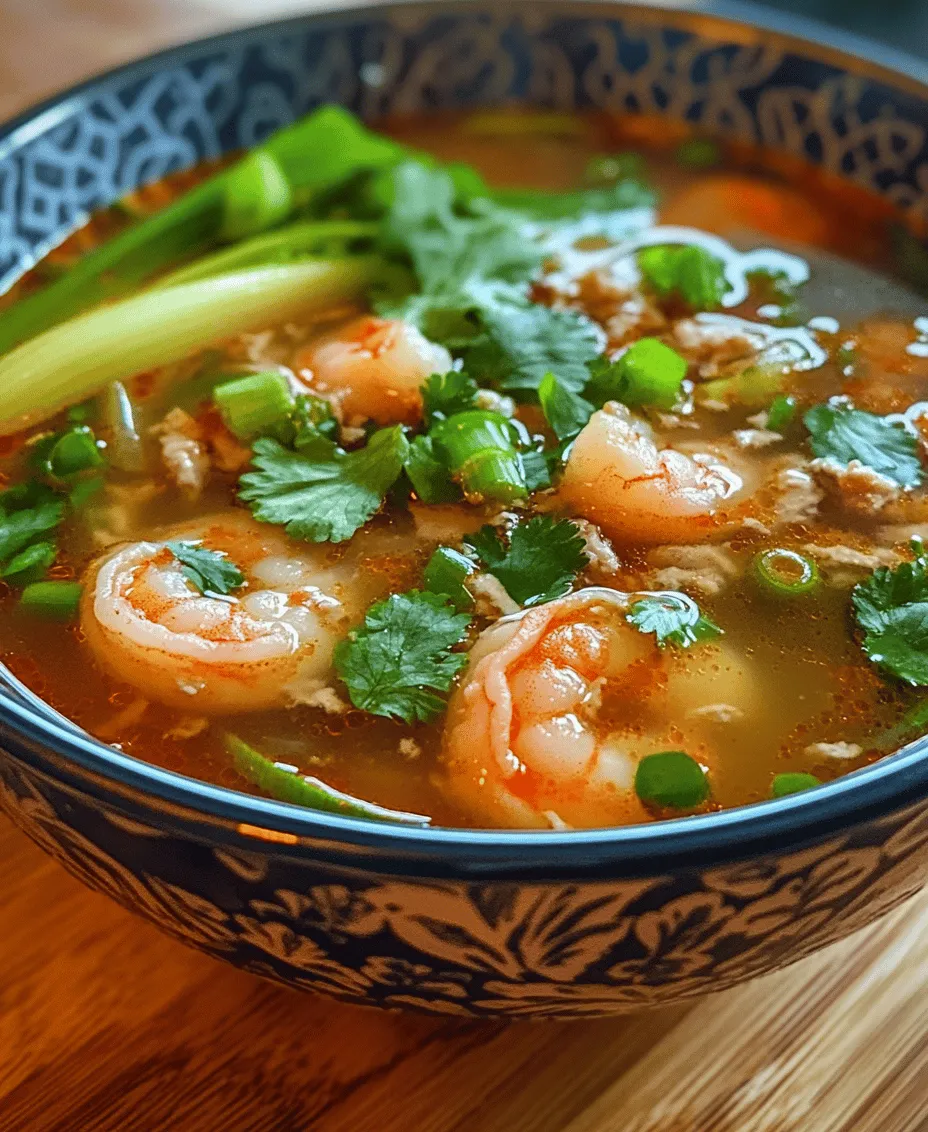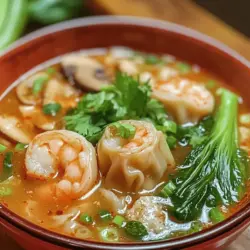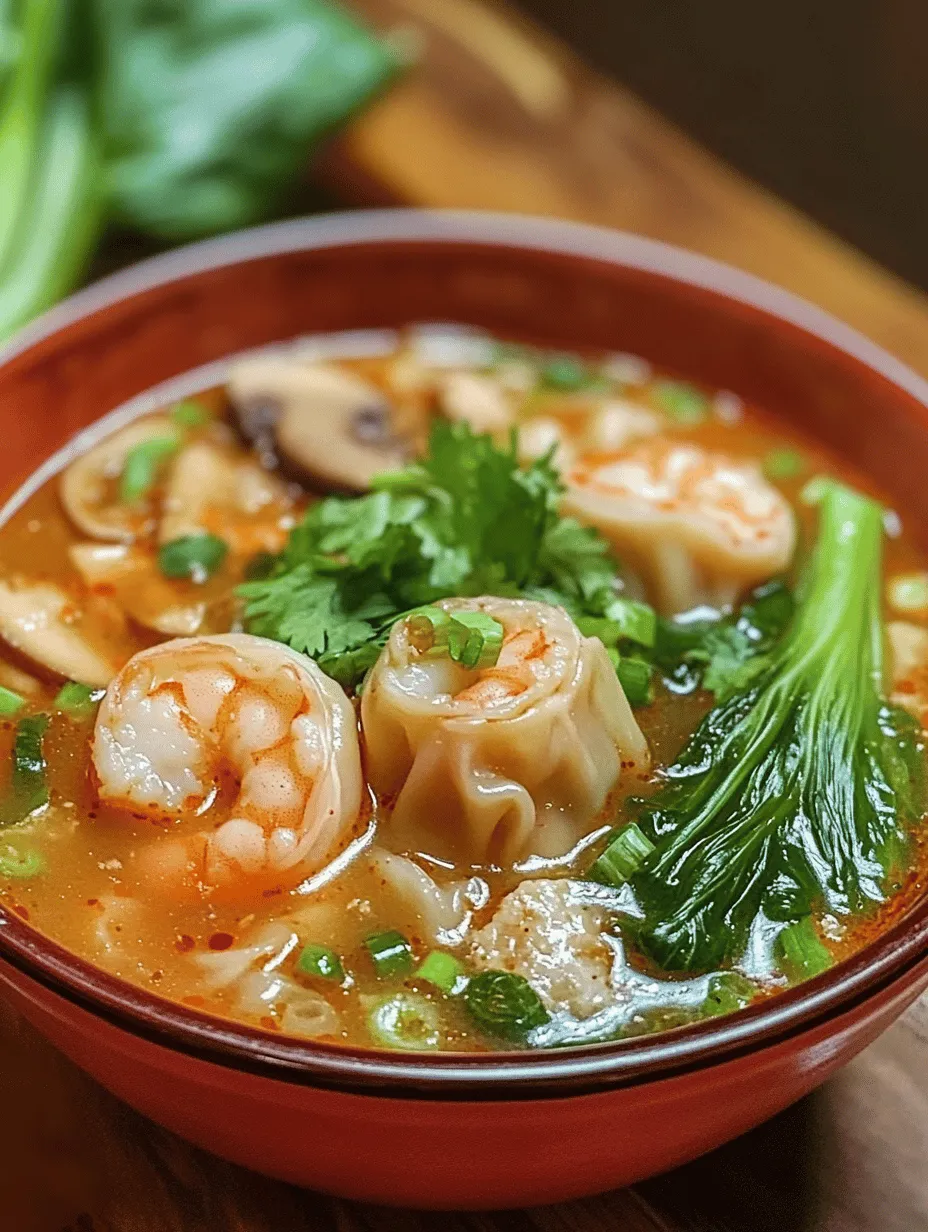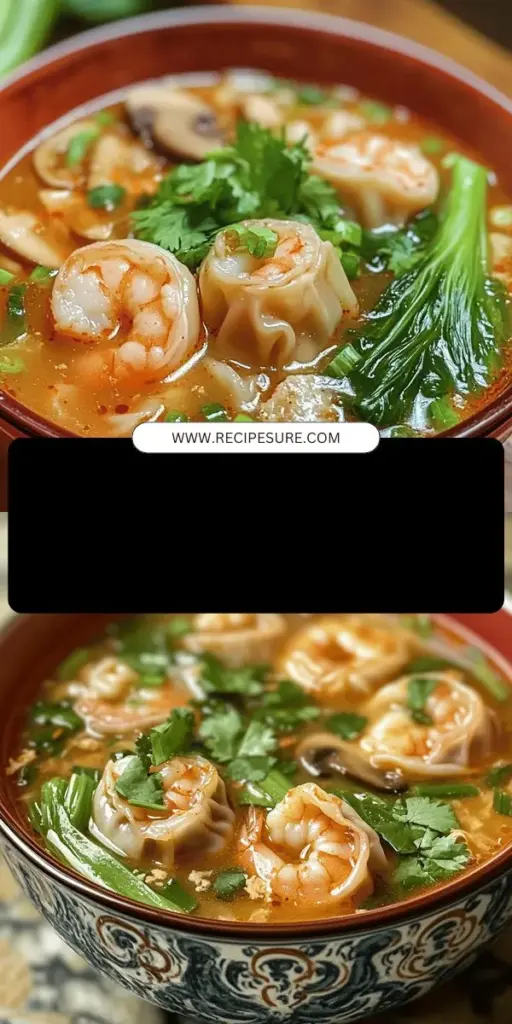Introduction
Wonton soup is a beloved dish in the realm of Asian cuisine, particularly within Chinese culinary traditions. Known for its delicate dumplings filled with savory ingredients, this soup is a staple in many households and restaurants across the globe. Its rich flavors and comforting broth make it a go-to choice for family gatherings, celebrations, or simply when you need a little warmth and comfort on a chilly day.
The cultural significance of wonton soup transcends mere nourishment. It often evokes memories of family meals, shared stories, and cultural heritage. Each bowl of wonton soup tells a story, drawing from centuries of tradition and regional flair. Whether enjoyed in a bustling dim sum restaurant or crafted at home, this dish embodies the essence of comfort food in Asian culture.
What makes our delightful wonton soup recipe truly unique is the harmonious combination of ground pork and shrimp. This duo not only enhances the flavor profile but also adds a delightful texture that elevates each bite. The rich, umami-packed broth, combined with tender wontons and fresh vegetables, creates a symphony of flavors that is sure to please anyone’s palate.
Understanding Wontons
To truly appreciate wonton soup, it is essential to understand the wontons themselves. Wontons are a type of dumpling traditionally filled with a mixture of meat, seafood, or vegetables, and they hold a special place in Chinese cuisine. The history of wontons dates back to the Song Dynasty (960-1279 AD), and they have evolved over the centuries, becoming a prominent dish in various regional cuisines throughout China.
Different regions of China have their own unique takes on wontons, with variations in fillings, shapes, and cooking methods. For instance, Cantonese wontons are typically filled with a combination of shrimp and pork, often served in a clear broth, while Sichuan wontons are known for their bold, spicy sauces. The beauty of wonton soup lies in its versatility; you can adapt the fillings and cooking style to suit your taste preferences and regional influences.
The wonton wrappers themselves are an essential component of the dish. Made primarily from wheat flour, egg, and water, these thin sheets are pliable and can be easily shaped to encase the filling. The quality of the wrappers can vary, with some being homemade and others store-bought. When selecting wonton wrappers, look for those that are smooth, thin, and flexible, as they will yield the best results when boiled or steamed.
Ingredients Breakdown
Creating a delightful wonton soup requires a thoughtful selection of ingredients that contribute to both flavor and nutrition. Here’s a detailed breakdown of the key ingredients used in this recipe:
Ground Pork
Ground pork serves as the primary protein in our wonton filling. Its rich flavor and tender texture make it a popular choice in many Asian dishes. Not only is ground pork delicious, but it also offers several nutritional benefits. It is a good source of protein, essential vitamins, and minerals like iron and zinc, which are crucial for maintaining energy levels and supporting immune function. When selecting ground pork, look for cuts that are slightly fatty, as the fat adds moisture and flavor to the wontons.
Shrimp
In addition to ground pork, shrimp adds a delightful oceanic flavor and a unique texture to the wonton filling. This versatile seafood is low in calories and high in protein, making it an excellent choice for health-conscious eaters. Shrimp is also rich in omega-3 fatty acids, which are beneficial for heart health, and contains essential nutrients such as vitamin B12 and selenium. When preparing shrimp for the filling, ensure they are fresh or thawed if previously frozen. Peel and devein the shrimp, then chop them into small pieces for easy incorporation into the filling mixture.
Green Onions and Water Chestnuts
Green onions, also known as scallions, bring a fresh, mild onion flavor to the wonton filling. They add a pop of color and a bit of crunch that enhances the overall texture of the soup. Additionally, green onions are rich in vitamins A and C, which are important for maintaining healthy skin and boosting immunity.
Water chestnuts contribute a delightful crunch and subtle sweetness to the filling. These crunchy vegetables are low in calories and high in fiber, making them an excellent addition to a healthy diet. When using canned water chestnuts, be sure to rinse them thoroughly before chopping and adding them to the filling.
Garlic, Soy Sauce, Sesame Oil, and Ginger
To elevate the flavor of the wonton filling, we incorporate aromatic ingredients like garlic, soy sauce, sesame oil, and ginger. Garlic adds depth and a savory element to the mixture, while ginger imparts a warm, spicy note that complements the other flavors beautifully. Soy sauce provides umami richness and saltiness, enhancing the overall taste of the filling. Lastly, sesame oil adds a nutty aroma and flavor that ties all the ingredients together, giving the wontons an authentic Asian taste.
Overview of the Soup Components
The soup base is just as important as the wontons themselves. A rich, flavorful broth is essential for a satisfying wonton soup experience. Here’s a closer look at the key components of the soup:
Chicken Broth
Chicken broth serves as the foundation of our wonton soup, providing a savory and comforting backdrop for the dumplings. When selecting chicken broth, opt for high-quality, low-sodium varieties to control the salt level in your dish. Homemade chicken broth is always a fantastic option, as it allows you to customize the flavor and ensure freshness. If you prefer a vegetarian version, vegetable broth works well as a substitute, maintaining the soup’s comforting essence.
Bok Choy and Mushrooms
Bok choy is a delicious leafy green that adds nutritional benefits and visual appeal to the soup. It is low in calories while being rich in vitamins A, C, and K, as well as calcium and iron. When preparing bok choy, make sure to wash it thoroughly and slice it into bite-sized pieces for easy incorporation into the soup.
Mushrooms, whether shiitake, button, or oyster, bring an earthy flavor and meaty texture to the broth. They are a fantastic source of antioxidants and provide a unique umami taste that enhances the overall depth of flavor in the soup. When adding mushrooms to the broth, slice them thinly for even cooking and maximum flavor infusion.
Seasonings
To create the perfect balance of flavors in the wonton soup, we’ll use a combination of seasonings, including soy sauce, oyster sauce, and white pepper. Soy sauce adds a savory umami punch, while oyster sauce contributes a touch of sweetness and complexity. A pinch of white pepper adds a subtle heat and aromatic quality that rounds out the flavors beautifully.
Step-by-Step Instructions
Now that we’ve covered the background of wonton soup and the essential ingredients, let’s dive into the step-by-step instructions for making the wontons.
Making the Wontons
1. Prepare the Filling: In a large mixing bowl, combine the ground pork, chopped shrimp, finely chopped green onions, and water chestnuts. Add minced garlic, grated ginger, soy sauce, sesame oil, and a pinch of salt and pepper. Mix well until all the ingredients are evenly incorporated. For the best texture, use your hands to mix the filling, ensuring that the ingredients are well combined without overmixing.
2. Assemble the Wontons: Take a wonton wrapper and place a small spoonful (about 1 teaspoon) of the filling in the center. Be careful not to overfill, as this may cause the wontons to burst during cooking. Moisten the edges of the wrapper with a little water using your finger. Fold the wrapper in half diagonally to form a triangle, pressing out any air pockets as you seal the edges. For an added touch, you can bring the two opposite corners of the triangle together, pinching them to form a traditional wonton shape.
3. Repeat and Prepare: Continue assembling the wontons until all the filling is used. Place the finished wontons on a baking sheet lined with parchment paper to prevent sticking. If you are not cooking the wontons immediately, you can freeze them at this stage for future meals. Just make sure to separate them with parchment paper to avoid clumping together.
4. Cook the Wontons: When you’re ready to enjoy your wonton soup, bring a large pot of water to a gentle boil. Carefully add the wontons to the pot, stirring gently to prevent them from sticking to the bottom. Cook for about 3-4 minutes or until the wontons float to the surface and are fully cooked. Remove them from the pot with a slotted spoon and set them aside while you prepare the broth.
With the wontons prepared, the next step is to create the flavorful broth that will bring your delightful wonton soup to life. Stay tuned for the continuation of this recipe, where we will guide you through the process of crafting the perfect broth and combining all the elements for a truly comforting bowl of wonton soup.

Ideas for Variations in Fillings Based on Dietary Preferences
One of the joys of making wonton soup is the versatility of the fillings you can create based on dietary preferences. Traditional pork and shrimp fillings are popular, but don’t hesitate to experiment with a variety of ingredients to suit your needs or preferences:
- Vegetarian Options: For a plant-based filling, consider using a mix of finely chopped mushrooms, tofu, and vegetables like bok choy and carrots. Adding spices such as garlic, ginger, and sesame oil will enhance the flavor profile.
- Gluten-Free Choices: If gluten is a concern, opt for rice paper wrappers instead of wonton wrappers. Fill them with a combination of minced chicken, scallions, and cilantro for a delightful twist.
- Low-Carb Adaptations: For a low-carb version, use shredded cabbage or zucchini as a wrap, and fill with a mixture of ground meat and herbs for a satisfying bite without the extra carbs.
- Spicy Fillings: If you enjoy a kick, add minced chili peppers to your filling or use spicy sausage. This will give your wontons an exciting flavor that pairs perfectly with the savory broth.
- Seafood Variations: Try using crab meat, scallops, or a combination of seafood for a luxurious and flavorful filling. Pairing these with a hint of lime or lemongrass can elevate the dish to new heights.
Preparing the Soup
Instructions for Simmering the Broth and Incorporating Flavors
To create a flavorful broth for your wonton soup, begin by heating a large pot over medium heat. Add a tablespoon of oil, then sauté aromatics such as minced garlic, ginger, and chopped scallions until fragrant, about 1-2 minutes.
Next, pour in about 8 cups of chicken or vegetable broth. If you want an added depth of flavor, consider using homemade stock. Bring the broth to a gentle simmer.
To elevate the taste further, incorporate soy sauce, sesame oil, and a splash of rice wine. These ingredients will contribute umami richness and complexity to your soup. For a hint of sweetness, add a small piece of rock sugar or a dash of sugar to balance the savory elements.
Importance of Timing When Adding Vegetables for Optimal Texture
When simmering your broth, it’s crucial to time the addition of vegetables correctly to ensure they maintain their texture. Start by adding heartier vegetables, such as carrots and snow peas, about 5-10 minutes before you plan to serve the soup. This will allow them to cook through without becoming mushy.
For quicker-cooking vegetables like bok choy or spinach, add them just a couple of minutes before serving. This way, they retain their vibrant color and crispness, enhancing both the visual appeal and texture of your dish.
Cooking the Wontons
Technique for Adding Wontons to the Soup Without Breaking Them
Once your broth is simmering and vegetables are added, it’s time to cook the wontons. Gently drop them into the broth one at a time. Avoid crowding the pot, as this can lead to the wontons sticking together or breaking apart.
Use a slotted spoon to stir the broth gently, ensuring the wontons float and have enough space to cook evenly. Let them simmer for about 4-6 minutes, depending on the size of your wontons.
Signs That Indicate the Wontons Are Fully Cooked
To check if your wontons are done, look for a few key signs. First, the wontons should float to the surface of the broth, indicating that they are cooked through. Additionally, you can cut one open to ensure the filling is no longer pink and that it’s hot throughout.
Once the wontons are cooked, remove the pot from heat, allowing the flavors to meld together for a minute before serving.
Serving Suggestions
Presentation Ideas for a Visually Appealing Dish
Presentation is key when serving wonton soup. Use a large bowl to showcase the floating wontons and vibrant vegetables. Place the wontons in the center and carefully ladle the broth around them.
For an appealing touch, consider placing a few fresh herbs, such as cilantro or green onions, on top of the soup. This not only adds color but also enhances the aroma.
Recommended Garnishes and Their Flavor Contributions
Garnishing can elevate your wonton soup to a restaurant-quality dish. Here are some suggested garnishes and their contributions:
- Chopped Green Onions: Adds a fresh, oniony crunch that complements the soup’s flavors.
- Cilantro: Provides a burst of freshness and brightness.
- Chili Oil or Sriracha: Enhances the soup with a spicy kick, perfect for those who enjoy heat.
- Sesame Seeds: Adds a subtle nuttiness and visual appeal.
Options for Customizing the Soup
Your wonton soup can easily be customized to match your preferences. For a richer flavor, drizzle in some chili oil for heat or a splash of soy sauce for added saltiness. You can also add different vegetables like mushrooms, bok choy, or baby corn based on what you have available or what you enjoy.
If you prefer a more substantial meal, consider serving the soup with a side of steamed rice or noodles to soak up the delicious broth.
Nutritional Information
Breakdown of Nutritional Content Per Serving
Homemade wonton soup can be a nutritious meal option, especially when packed with vegetables and lean protein. A typical serving (approximately 2 cups) contains:
- Calories: 250-300
- Protein: 15-20 grams
- Carbohydrates: 30-35 grams
- Fat: 10-15 grams
- Fiber: 2-4 grams
The exact nutritional content will vary based on your specific ingredients and portion sizes, so consider adjusting accordingly to meet your dietary needs.
Discussion on the Health Benefits of Homemade Soup Versus Store-Bought Options
One of the significant advantages of making wonton soup at home is controlling the ingredients. Homemade soup allows you to avoid preservatives, excess sodium, and unhealthy fats often found in store-bought versions.
Additionally, you can tailor the soup to be as nutritious as possible by incorporating fresh vegetables and lean proteins, making it a healthier option for families and individuals alike.
Considerations for Dietary Restrictions
For those with specific dietary restrictions, making wonton soup at home offers several benefits:
- Gluten-Free: By using gluten-free wrappers or alternatives like cabbage leaves, you can enjoy wonton soup without gluten.
- Low-Carb: Adjusting the recipe to reduce or eliminate noodles and using more vegetables can create a low-carb option for those following a ketogenic diet.
- Vegan: By using vegetable broth and plant-based fillings, this soup can be adapted to fit a vegan lifestyle.
Cultural Context and Variations
Exploration of Wonton Soup Across Different Cultures
Wonton soup is a beloved dish not only in Chinese cuisine but also around the world. Each culture has adapted the concept to fit local tastes and ingredients.
In Hong Kong, wonton soup is often served with thin egg noodles, while in Taiwan, it may be paired with a spicy dipping sauce. In contrast, in the Philippines, wontons are sometimes served in a rich, creamy broth.
Variations of the Recipe That Can Be Found Globally
Different regions have put their spin on wonton soup:
- Vietnamese Wonton Soup (Súp Hoành Thánh): This version often includes a clear broth flavored with star anise and served with fresh herbs.
- Thai Wonton Soup: Incorporating coconut milk and Thai spices, this version introduces a rich, creamy texture with a hint of sweetness.
- Japanese Wonton Soup (Wonton Ramen): Often served as a ramen dish, this soup combines wontons with rich miso broth and various toppings like nori and soft-boiled eggs.
Personal Anecdotes or Stories Related to Enjoying Wonton Soup
Many home cooks have fond memories of making wonton soup with family or friends. Whether it’s a family tradition during Lunar New Year celebrations or a comforting bowl shared on a rainy day, the experience of crafting this dish can foster connections and create lasting memories.
Conclusion
In summary, making delightful wonton soup is not only a rewarding culinary experience but also a wonderful way to enjoy a comforting meal. The combination of tender wontons filled with your choice of delicious ingredients, nestled in a flavorful broth, offers a delightful experience that’s hard to resist.
I encourage you to try this recipe and explore the joys of creating your own versions, whether you stick to traditional fillings or venture into new flavor territories. Homemade wonton soup captures the essence of comfort food—delicious, nourishing, and perfect for sharing with loved ones. The process of making soup, with its aromas and warmth, has a unique way of bringing people together, making it a cherished dish across cultures. Enjoy the process and the delightful flavors that come with it!


